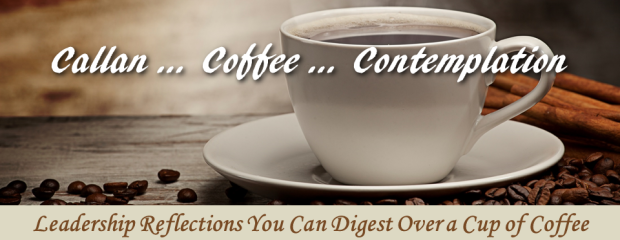Callan…Coffee…Contemplation for the Week of August 18th
The Great Chain
One of the most vital things leaders do for their groups is provide coherence; a sense of meaning, purpose, and shared intentionality connecting past, present, and future. I like to think of coherence as “the great chain”—the perennial knowledge that links and binds individuals into groups across time. There are several ways leaders can build the great chain. First, define and celebrate the group’s ethos. Ethos answers elementary questions such as who are we? What do we stand for? What do we do? Second, create a deep sense of meaning around which all tactics, techniques, procedures, and policies align. Third, clearly articulate those things which are non-negotiable. When people know and trust the enduring cornerstones of our groups, the non-negotiables, the links in the great chain become stronger, and interestingly, people don’t need to be told to keep them strong; they do so on their own accord. Leaders should focus great effort on building and maintaining the great chain—those primary and unbreakable links that create coherence, congruence, and peak experiences.
How You Knew
One thing I recall from my Philosophy 101 course in college was the term epistemology, which essentially means “how we come to see what we see.” I remember my professor saying we first had to understand how we knew, before we could ever start to understand what we knew. Why? Because we need to understand our lens—our inherent biases and preferences—which like a lens of glass will refract, magnify, or even distort what we saw. For example, this is why two politicians, one from the left and the other from the right, can look at exactly the same situation and see it two completely opposing ways. What they are seeing is objective and a matter of fact; how they are seeing it is highly subjective and not necessarily rooted in fact. As leaders, this lesson from my Philosophy professor is highly applicable. We too need to understand how we knew, and how we saw, before we can understand what we knew and what we saw. Through self awareness, reflection, and a willingness to hear truth from those around us, we can develop a truer lens, a better paradigm, to make us more effective leaders.
What Kind of Leader Do You Want To Be?
That leadership is hard, especially if pursued purposely as a master craft, is a fact. And in pursuit of masterful leadership, we often make the ends and means far too complex and technical. To gain a simpler approach to one’s paradigm, I believe answering this direct question to yourself will serve quite well for a trusty azimuth in one’s leadership journey: “What kind of leader do you want to be?” In all of us, there are two internal impulses that call to be fed; one is our higher impulses and the other is our lower impulses. Both impulses exist within each of us at all times. What differentiates great leaders from bad ones is their inner discipline to gradually honor the positive impulses and tame the lesser ones. I like this Native American Chief’s reflection on this very point, where he says “There are two dogs inside of me. One is mean spirited, angry, and petty. The other dog is positive, uplifting, and noble.” Someone then asks the Chief which dog usually wins, to which the Chief replied, “The one I feed the most.”
Holon
Holon is a Greek word meaning something that is simultaneously whole but also part of something larger. I like this holon image because I think it represents a leader with great integrity. Integrity fundamentally means wholeness of oneself; an undivided person whose interior life is fully in accord within itself and the outer world. When we say a leader has great integrity, what we mean is he or she is unbroken—there is no major schism in their personality and soul. I believe if one walked around a workplace and asked this question, “How do you describe a really great leader?”, the answers would all essentially reduce to integrity. What makes us willingly follow another is the leader’s wholeness; who they say they are, they in fact, are. And they are that same person every day. They are trustworthy, consistent, dependable, self-regulated, and accountable. So I like to remind myself of the holon–of the criticality of integrity–by reflecting on this simple question each day: “Is the person I see in the mirror each day the same person others see when they look at me each day?” It should be.
Wrestling
Every leader will face moral and ethical dilemmas in the course of their lives. We will constantly be in a wrestling match between our higher and lower impulses. Once we decide to be leaders, and live a life of leadership, inherent in our vocation is the constant reality of hard choices and vexing dilemmas. As leaders, we can’t limit or reduce these dilemmas; they are part of the geography and tapestry of leading. The best we can do, as we seek self mastery and a trusted inner compass, is to constantly remember this guiding principle: When confronted with a dilemma, choose the alternative that is the most morally demanding. Don’t settle for convenience or efficiency; chose the higher road and the harder path to ensure alignment with one’s integrity and virtue. As leaders, especially senior leaders entrusted with great responsibility, authority, and influence, we must always remember and strive to honor this maxim of leadership as expressed by others throughout history: “There is no right way to do the wrong thing.”
Check back next Monday for a round up of this week’s social media shares. Or check us out on Facebook,Twitter, Google+, or Pinterest to see our posts every day!
Tweet Share






